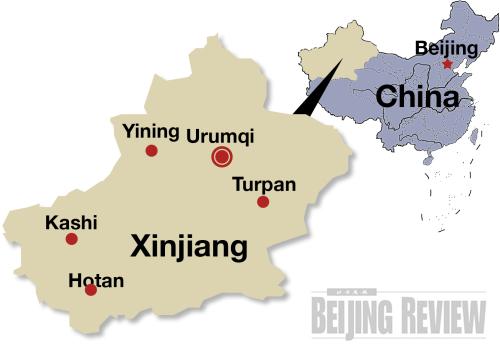|
"It was a violent crime that was premeditated and organized. It was instigated and directed from abroad, and carried out by outlaws in the country," a government statement said early July 6.
Control measures
As of July 7, the police had arrested 1,434 people who were suspected of involvement in the Urumqi unrest, of whom 1,379 were males and 55 were females. Police are still searching for about 90 key suspects in the city.
"Police have tightened security in downtown Urumqi's streets and at key spots such as power and natural gas facilities, as well as TV stations, to prevent large-scale riots," said Liu Yaohua, Director of the Department of Public Security of Xinjiang Uygur Autonomous Region.
More than 20,000 police officers have been dispatched around the city to tighten up security, focusing their efforts on Tuanjie Road, Erdaoqiao and the Outer Ring Road where rioters gathered on July 5.
Checkpoints have been set up in Urumqi's key areas as well as neighboring Changji and Turpan prefectures to prevent rioters from fleeing, Liu announced. He also said that more than 100 ethnic officials from adjacent areas have been transferred to Urumqi to help interrogate suspects.
Debris was cleared from the roads in the early morning hours of July 6. From 1 a.m. to 8 a.m. on July 6, traffic control measures were adopted in part of Urumqi, and the city government also instituted "comprehensive traffic control" from 9:00 p.m. on July 7 to 8:00 a.m. on July 8 to avoid further chaos.
At a July 6 press conference, Secretary of the Urumqi Municipal CPC Committee Li Zhi said that a total of 260 vehicles were destroyed, including 190 buses, at least 10 taxis and two police cars, and 203 shops were destroyed. Rioters also set 220 fires that engulfed about 56,850 square meters of the city and damaged two buildings.
Li admitted that Internet access was cut in parts of Urumqi after the riot. "We cut Internet connections in some areas of Urumqi to quickly quash the riot and prevent violence from spreading to other places," he said.
All the 1,103 injured people were still receiving medical treatment in 10 hospitals in Urumqi as of July 7, according to the police. The youngest victim, a six-year-old girl, was hit in the head with a brick while she was out shopping with her grandmother.
In the meantime, the police are using DNA technology to identify some of the dead and more than 100 people had already been identified as of July 8.
Urumqi Mayor Jerla Isamudin said on July 8 that the government will allocate about 100 million yuan ($14.6 million) in comfort funds for victims of the violence, including the injured, disabled and families of the dead.
The government will also provide aid to enterprises that suffered great losses to help them resume operations as soon as possible, the mayor said.

Xinjiang
Xinjiang Uygur Autonomous Region in the border area of northwest China covers about 1.66 million square km, accounting for one sixth of Chinese territory.
The region has a population of about 21 million, of whom 60 percent are ethnic minorities. There are 47 ethnic groups in Xinjiang, mainly Uygur, Han, Kazak, Hui, Mongolian, Kirgiz, Xibe, Tajik, Ozbek, Manchu, Daur, Tatar and Russian. The region has five ethnic autonomous prefectures for four ethnic groups—Kazak, Hui, Kirgiz and Mongolian, six ethnic autonomous counties and 43 ethnic autonomous townships.
The gross domestic product of Xinjiang topped 400 billion yuan ($58.9 billion) in 2008.
Major religions in Xinjiang are Islam, Buddhism (including Tibetan Buddhism), Protestantism, Catholicism and Taoism. Shamanism still has considerable influence among some ethnic groups.
Since the Han Dynasty (206 B.C.-220 A.D.) established the Western Regions Frontier Command in Xinjiang in 60 B.C., the Chinese Central Governments of all historical periods have exercised military and administrative jurisdiction over the region.
(Source: Xinhua News Agency)
| 